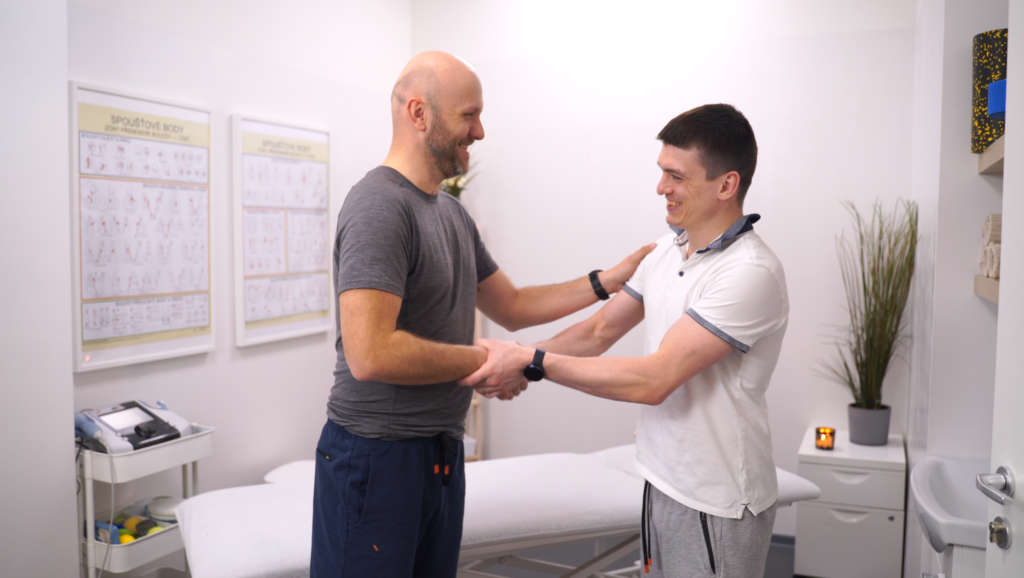The path to health is made up of many factors, and a visit to our centre is just one of the many pieces of the puzzle. The key to healing is in you and your attitude. Be as precise as an athlete preparing for the Olympics. Or an astronaut preparing for a flight to the moon. Learn these 7 simple rules for your health:
-
Follow the therapy program, especially outside the center.
Targeted therapy based on a detailed examination is often essential to the healing process, but it is far from everything. Remember that the time you spend in our centre is only a small fraction of the time you spend at home or at work. If therapy were the only place of change for the better, the effect would be hard to come by. -
Manage workload and stress.
Just as an athlete does not improve during training, but during recovery. So too, each of us restores our health and functional capacities precisely during rest, when the parasympathetic nervous system comes into dominance. However, this can be disrupted by too much stress, when we “turn up the speed” and overwhelm the parasympathetic counterpart, the sympathetic nervous system. Many health problems can often only be solved by correcting them in the area of appropriate workload and stress levels. -
Get enough quality sleep.
Sleep is closely linked to point two and the parasympathetic nervous system. In addition, a high amount of the growth hormone cranial for regeneration is flushed out during sleep. Lack of sleep increases the risk of diabetes, hypertension, heart disease, stroke and even injury (especially in sports). -
Learn to relax and induce mental well-being.
What is unpleasant stress for us and what stimulus can throw us off balance depends on our current mental state and setup. Surely they have encountered that the same life situation can be a tragedy for one person, while another waves his hand. Despite the same external stimulus, however, there is a diametrically different response of the organism. The ability to relax and use various relaxation techniques helps us to reduce stress levels and sympathetic nervous system activity. On the contrary, to support the parasympathetic nervous system or the ability to fall asleep without problems and the ability to enjoy a good night’s sleep. -
Get plenty of varied exercise.
Lack of exercise and especially varied exercise is one of the main problems of this time. The result is an epidemic of obesity, diabetes, osteoporosis, psychological problems and musculoskeletal pain. You don’t have to go to the gym every day to eliminate the most significant risks. Try to use the lift less and the stairs more. Less car and more walking or cycling. Don’t sit for hours without moving, but put in a few small movement activities that not only get you moving, but can also increase your overall efficiency. -
Feel your body responding to different stimuli and mark your findings.
The therapy process should always be individualised and continuously evolving. However, this can only be done well if we have enough information not only before the therapy but especially during it, how the condition changes and how you react to different stimuli. The only person who is with you all the time is you. Yes, it’s hard to objectify or remember even a little bit of the important stuff, which is why you need to consciously do “self-inquiry” and keep a running record of your findings. -
Take care of yourself as someone for whom you have responsibility.
One of the biggest problems is when clients only do so-so. Most often just so that it doesn’t hurt them so much, sometimes even just so that they don’t tell, even if the effect is nonexistent. No, there is no point in exercising once a week for 5 minutes. But what if our pet or our child has a health problem? There, in the vast majority of cases, the situation is diametrically opposed. We pay for examinations and therapies even with the best specialists, we buy medicines, which we carefully dose. We find out more about the causes of the disease and treatment options, we supervise the adherence to the regimen and everything else is subordinated to the healing process. Thanks to this approach, in the vast majority of cases, healing does come.
Reflect on these points and think about how your behaviour, attitude and treatment would change if you followed these 7 rules. Consequently, change your approach not only to therapy but to life as a whole and step onto the path of health and a happy life.
Council in conclusion:
Print out these 7 key points and stick them in the places where you spend the most time so you have a constant reminder of what will move you forward:
-
Follow the therapy program, especially outside the center.
-
Manage workload and stress.
-
Get enough quality sleep.
-
Learn to relax and induce mental well-being.
-
Get plenty of varied exercise.
-
Feel your body reacting to different stimuli and make a note of the findings.
-
Take care of yourself as someone for whom you have responsibility.

